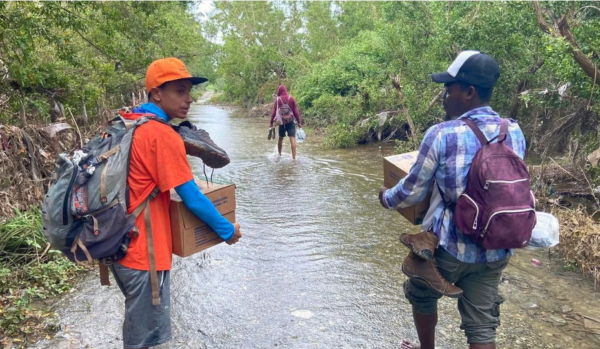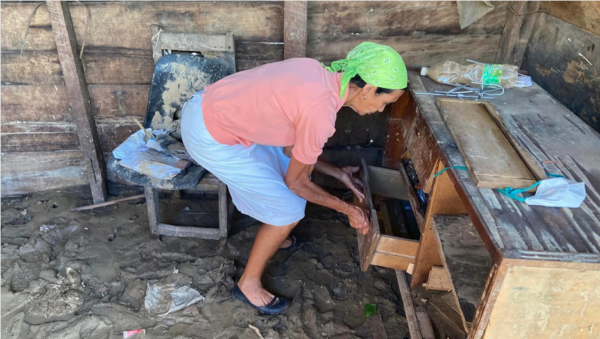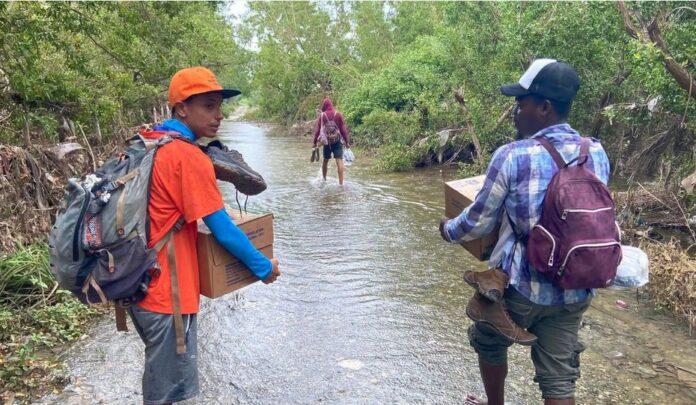“We go to where no one has gone.”

By Yenys Laura Prieto (El Toque)
HAVANA TIMES – Around Yainet, there’s only muddy clothes, dirty bottles, and pieces of wood. Two single mattresses lie on the damp ground. She holds her oldest daughter by the hand and has a baby in her other arm. They are barefoot. They survived Hurricane Oscar, but the structure of what they knew as home broke apart in the early hours of October 21, 2024.
The wood plank walls have holes, and the floor is a trench where it’s barely possible to walk. From the ceiling beams hang some damp rags. Outside, in the sun, lies what little she managed to save after the flood: two old wooden chairs and some pots covered in mud. Yainet Londres lives in San Antonio del Sur, Guantanamo, where 2,282 houses were damaged by the storm; 1,183 homes lost their roofs, and there were 51 total collapses.
She is also one of the 168,540 Guantanamo residents living in vulnerable communities, part of the 53,000 families in “social disadvantage” in the province, according to state reports. However, seven days after Oscar’s impact, she had yet to receive help. The photos of Yainet and her children are from October 28, 2024.
“This is the condition of my cousin’s house in San Antonio, a mother of two young children, as you can see. They still haven’t received aid because they live far from the town, beyond the Mincin [Ministry of Domestic Trade]. Today, she managed to reach a church where they gave her cooked food, but it’s hard for her to get to town due to the road conditions,” a relative wrote on Facebook, urgently calling for attention for the Guantanamo mother.
She is not the only one. In recent days, numerous calls for help on social media show the reality of mothers and children, elderly, and vulnerable people who have lost all their belongings.
Cubans from different provinces and those living abroad have organized autonomously to send food, clothes, and medicine to the affected communities, even though the economic crisis limits resources. In the face of the Cuban state’s inaction, the notion that “the people save the people” is more relevant than ever.
However, limited experience with such situations and the lack of information about affected communities complicate the humanitarian work of independent activists. Several people in the most isolated areas have mentioned that aid is not reaching all places.
“I’ve seen on social media that many people have come to donate, but it seems no one informed them that in the Buena Vista Alley, 18 homes were covered by the river… I just want to remind people that no one has come here,” wrote Zaday Martinez, a resident of San Antonio del Sur.
From Macambo, a small community where at least five homes were destroyed, several families urgently need help, reported an activist known online as Canela Tudela, administrator of the page “Ministerio de Ayuda Dios es Amor.” Amid the destruction, Canela shared the story of a mother with two children, aged 3 and 6. “There’s no trace of my house left,” said the mother in a video; she is now sheltered in a private home with 22 other people.
The hurricane once again revealed Cubans’ spontaneous ability to mobilize in emergencies and the bureaucratic (and authoritarian) limitations that the government imposes on any type of organization outside the state.
New heroes against bureaucracy in Cuba
On October 30, 2024, the solidarity group “Aquí con el Héroe” announced on social media that just days before three of its members were to travel to Guantánamo, they were prohibited from transporting donations. “Help! They don’t want to let us load the luggage on the train; we only have four days left to leave, and we haven’t received a response,” one of the project’s founders posted.
“Remember that this donation was made by the people to help our sister province of Guantanamo. I wonder why so many obstacles. Our group is solely for help and solidarity. I think solidarity is needed a lot these days,” wrote another organizer on Facebook.
After hours of waiting and several clashes with local bureaucracy in Sancti Spíritus, “Aquí con el Héroe” administrators announced that they had finally obtained permission to transport donations from the people of Sancti Spiritus.

In Havana, many have also shown solidarity with the precarious situation of the residents of Imias and San Antonio del Sur. On October 30, the “Life’s Breath” project from Havana confirmed the arrival of its first shipment of humanitarian aid to Guantanamo. The six suitcases included clothes, shoes, sheets, towels, food, and personal hygiene products, each suitcase weighing over 90 pounds, totaling more than 540 pounds in donations.
Yankiel Fernández, founder of the group, used his Facebook profile to inform and invite the community, which typically donates to vulnerable elderly people and children with cerebral palsy. The initiative hopes to gather more donations to provide continuous support to those affected.
Independent activist Yamilka Laffita, known as Lara Crofs, reported that coordinators with purchased food are ready to make distribution packages, of course, entirely free. “I mention this for the first time because I feel the need after hearing reports of donation sales,” she warned in a post. Days earlier, Yamilka reported that three donation collection points had been set up in Havana, remaining active until October 28.
Yenier Toledano Torres, founder of the project “With Love All Together” for helping homeless and low-income people, said that thanks to coordination with various aid groups, they have been able to provide food and basic items to over 200 children, elderly, sick individuals, and people who lost everything.
A Cuban response beyond the government
“Eglis is a woman from Imias clinging to what remains of her house… I found her in the mud, trying to open a bottomless drawer, looking for something that was already useless in the mud,” said Daniel Ross, a young audiovisual producer from Guantanamo who independently organized humanitarian aid in the devastated areas.

Shortly after images of the hurricane’s aftermath began to surface, Daniel used his Facebook profile to show the difficult reality faced by the affected residents and to mobilize Cubans, inside and outside the country, to donate essential supplies.
Accompanied by local collaborators (other young artists and neighbors), he delivered food, medicine, and other essential items to affected families, especially elderly people who were isolated and without institutional support. “Thanks to the friends who received all the deliveries and challenges with me today… some, with their discourse of false modesty, say charity should be private, but if I don’t share this news, how would I have raised everything?” he wrote on his profile.
In his posts, Daniel Ross shows the precarious conditions in the affected areas: destroyed homes, elderly people without drinking water or food, and residents who, days after the disaster, were still waiting for help.
Since the incident, the young Guantanamo resident has shared almost daily stories of people who survived the hurricane with minimal resources. One story is of an elderly woman who had not received help until Daniel arrived; she described how she managed to save some food and protect herself with her pet. Another neighbor recounted his tragedy of losing over 150 animals and almost his entire farm.
In one video, the young artist describes the challenges faced by Guantanamo resident Maisi Orduñez after the hurricane:
—”I still can’t believe no one has come here.”
—”No one has come.”
—”They haven’t given you anything either?”
—”How did you survive all these days?”
Without government resources, Daniel’s team, like other humanitarian aid projects, relies on networking. Each supply delivery is accompanied by a brief message of hope. These solidarity actions are documented and serve to highlight the shortcomings of a system that has abandoned the residents of Imías and San Antonio del Sur.
“We go deep, where no one has gone,” Daniel said in an update on October 29, 2024. In photos shared on Facebook, he can be seen crossing a river with several young people, carrying boxes to assist families who were cut off.
With support from Cubans across provinces and abroad, independent groups have distributed clothes, medicine, and food to ease the daily lives of these communities. The Methodist Church of Guantanamo and other religious congregations have also sheltered dozens of people who lost their homes in San Antonio del Sur.
What began as an immediate response to the devastation caused by the natural disaster has become a continuous social aid and resilience effort. Above all, it demonstrates that networking and visibility on digital platforms can be effective when institutional support fails or is insufficient in critical times.
First published in Spanish by El Toque and translated and posted in English by Havana Times.
Read more from Cuba here on Havana Times.




